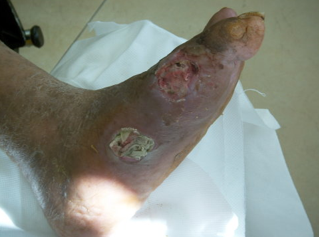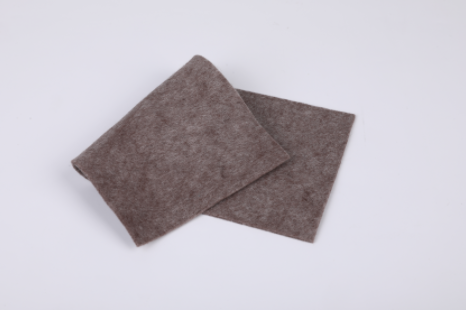When the blood flow in our legs is poor, a silent struggle begins quietly in the dark. Ischemic ulcer, a wound caused by insufficient blood supply, is like a forgotten island, longing for the nourishment of life. Poor blood flow is like land lacking water. Cells and tissues gradually wither on this dry land.
Of these, atherosclerosis is the most common culprit. Like a cunning thief, it silently blocks the lifeline to the legs. Once the arteries are blocked, the tissues in the legs lose the oxygen and nutrients they need to survive. The lack of nutrients causes cells to die and tissues to become damaged, and the damaged tissues cannot be repaired in time. All this makes ischemic ulcer like a wound that is difficult to heal, painful, and long.
Other diseases also contribute to the process. Inflammatory diseases such as lupus, high blood pressure, and high cholesterol are like greedy vampires, eating away at the blood flow in the legs. Lymphatic obstruction acts like a dam, preventing the normal return of blood, causing fluid accumulation in the legs, and exacerbating the formation of ulcers.
And by the time we notice these symptoms, it's often too late. Welts may appear on the legs, ankles, toes, and between the toes and appear as dark red, yellow, gray, or black patches. The raised edges around it seem to tell a painful story. What's even more alarming is that some wounds are so deep that bones are visible, and tendons are even exposed. They may be excruciatingly painful, or they may be completely numb. The skin on the legs has lost its luster, and become tight, dry, and hairless, which is shocking.
In this process, who is more likely to fall into this dilemma? The answer is those with poor circulation. Whether due to genetics, environment, or lifestyle habits, they are a high-risk group for ischemic ulcers. Other diseases such as inflammation, high blood pressure, high cholesterol, etc. may also become participants in this silent battle.
Faced with this predicament, we cannot sit still and wait for death. Self-care is our only option. In order to treat an ischemic ulcer, we must restore the blood supply to the leg. We can seek professional medical help, such as surgery, medicine, etc. At the same time, improving living habits is also key. Quitting smoking, controlling blood pressure and cholesterol, and exercising appropriately can all help improve blood circulation.
Ischemic ulcers are a complex problem that requires multifaceted treatment and care. However, as long as we don't give up and always face it positively, we will always find that ray of light in life. Let us work together to fight for our health and happiness! In our lives, no matter how big or small, we will always encounter some accidents and bring some wounds. Some wounds may be treated by ourselves, but others may require the intervention of a professional medical team. So, how should we provide scientific and reasonable care for these wounds?
First, keeping the wound clean is the most important thing. Imagine that an unwashed wound is like a seedling exposed to a sandstorm, extremely vulnerable to invasion by external bacteria. Therefore, cleaning the wound every day and dressing it with appropriate dressing is the first line of defense to prevent infection.
Furthermore, changing dressings is also a skill. The wound nurse will tell you when to change the dressing based on the condition of the wound. When changing the dressing, make sure the surrounding skin is dry. Excessive moisture will not only make the dressing ineffective but may also soften the surrounding healthy tissue, thereby affecting wound healing.
Some people may be wondering, is it possible to change the dressing yourself? Actually, this is a very thoughtful idea. But before operating, you must follow the doctor's instructions to ensure that every step is done accurately. If you find it difficult, home-visiting nurses are also a good choice. They will provide you with professional help.
But then again, prevention is always better than cure. The above measures are especially important if you are at risk for ischemic ulcers. Check your feet and legs every day, noting any color changes or areas of sores. Choosing the right shoes and socks and avoiding staying in the same position for long periods of time can help prevent ischemic ulcers.
In addition, changes in living habits are also key. Quitting smoking, controlling blood sugar, maintaining appropriate exercise, eating a healthy diet, and getting enough sleep are all important factors in improving blood circulation and helping wounds heal.
So, when should you seek help from a doctor? If the wound shows signs of infection, such as redness, swelling, increased pain, etc., you should go to the hospital immediately. Remember, prompt treatment is the key to healing wounds.
In short, whether it is preventing or caring for wounds, we need to treat them with a scientific and cautious attitude. Only in this way can we deal with wounds in the correct way without panicking or looking down upon them. When your body feels hot or swollen, it may be a warning signal. For example, when you have an injury that results in local swelling and yellow discharge, this may indicate a risk of infection. Also, if your wound is leaking cloudy fluid or has a foul odor, this could also be a sign of infection.
In addition to physical discomfort, you may feel a fever or chills, which may be because your body is fighting pathogens. Increasing pain may be your body's way of telling you that a certain area is being injured or that inflammation is getting worse. These are your body's way of telling you that you need to pay attention and take care of your health. Therefore, when you notice these symptoms, it is best to seek medical attention promptly for early treatment and management.
For more information on Innomed®Silver Ion Dressing, Refer to the Previous Articles. If you have customized needs, you are welcome to contact us; You Wholeheartedly. At longterm medical, we transform this data by Innovating and Developing Products that Make Life Life easier for those who need loving care.
Editor: kiki Jia
Date: January 6, 2024

 English
English عربى
عربى Español
Español русский
русский 中文简体
中文简体








